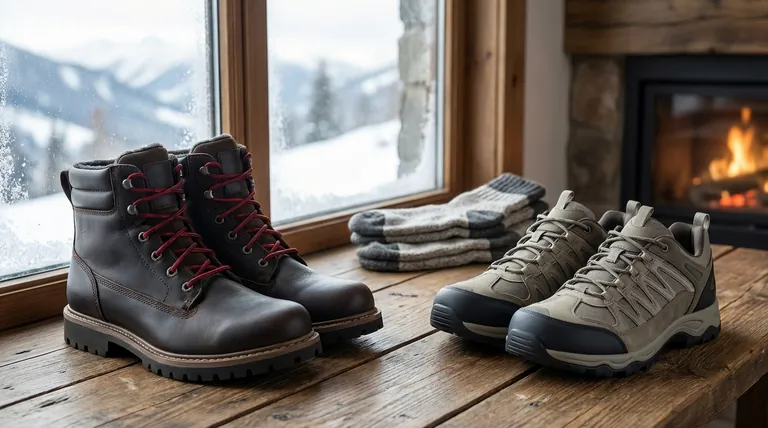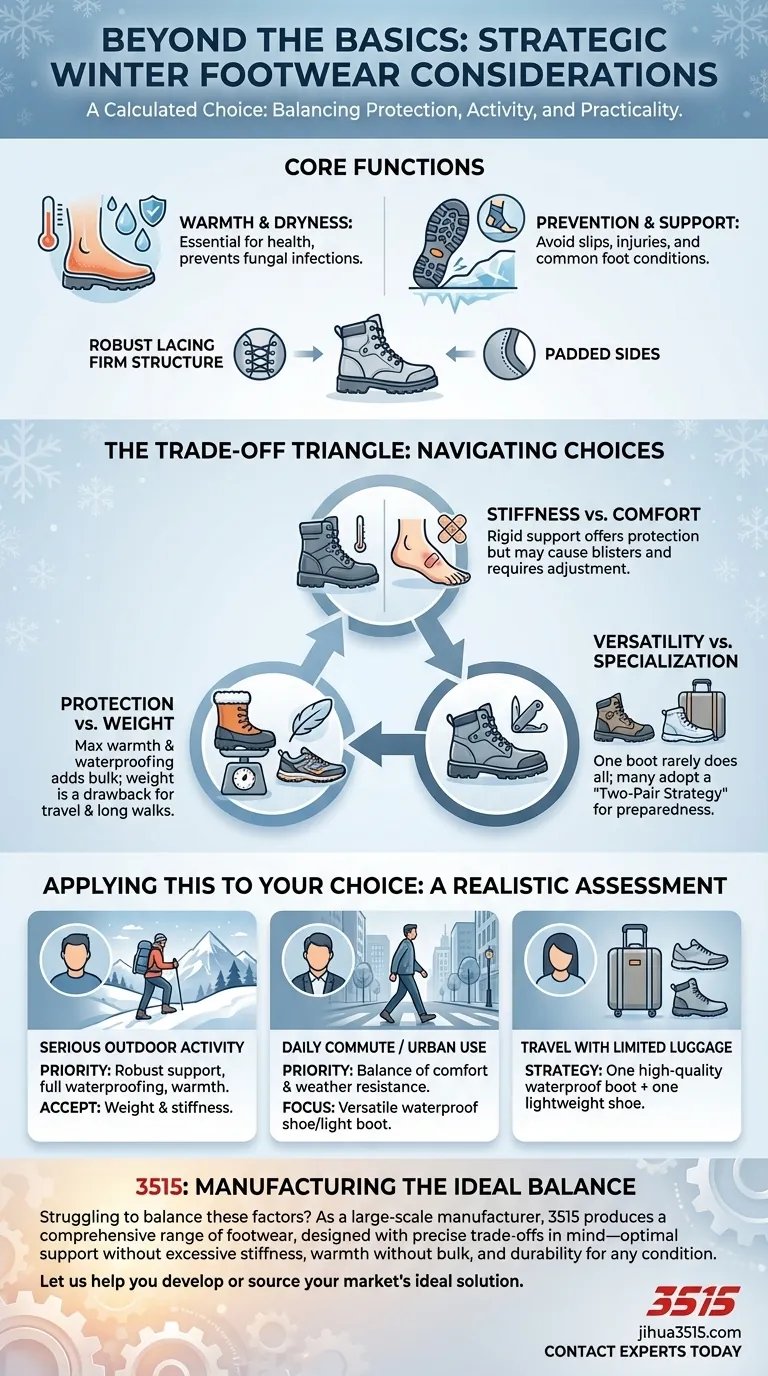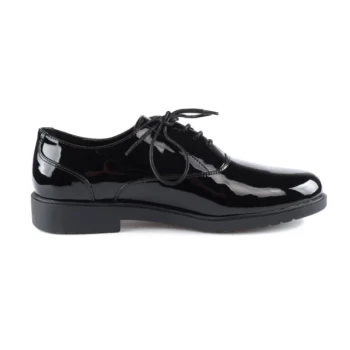Beyond the basics, key considerations for winter footwear involve balancing the protective features of a boot with practical factors like versatility, weight, and the potential for discomfort from overly stiff materials. You must also account for packing logistics, such as leaving space for thick socks and the value of bringing a backup pair.
The best winter footwear is not simply the warmest or most waterproof option available. It is a calculated choice that balances environmental protection against the specific demands of your activity, your foot's needs, and practical concerns like weight and versatility.

The Core Functions of Winter Footwear
Proper winter footwear serves as a critical barrier between you and the elements. Its primary functions are non-negotiable for safety and health during cold, wet conditions.
Maintaining Warmth and Dryness
Keeping your feet warm is essential for maintaining overall health in cold weather.
Equally important is keeping them dry. Waterproof capabilities are crucial for preventing moisture from getting in, which helps avoid discomfort and potential fungal infections.
Preventing Slips and Injuries
Winter surfaces are often icy and unpredictable. The right boots provide necessary traction to help avoid slips and falls, which can lead to significant injuries.
Proper support is also a key function. A well-structured boot helps prevent common foot-related conditions like ankle sprains, plantar fasciitis, tendonitis, and heel spurs.
How Support is Achieved
Support isn't just a feeling of tightness. It comes from specific design features.
Look for robust lacing systems, a firm overall structure, and padded sides that secure your foot and ankle, preventing unnatural movement on uneven terrain.
Understanding the Trade-offs
Choosing winter footwear involves navigating a series of trade-offs. Understanding them is key to selecting a boot that works for you, not against you.
Stiffness vs. Comfort
Many heavy-duty snow boots offer excellent ankle support but are also very stiff.
While this rigidity is protective, it can cause blisters or significant discomfort, especially for those with less stable feet. There is often an adjustment period required.
Protection vs. Weight
Maximum warmth and waterproofing often come in heavy, bulky thermal boots.
This weight and bulk can be a major drawback for travel or long-distance walking. This is why many thru-hikers, who prioritize comfort over long distances, opt for lighter trail runners, having conditioned their feet and ankles for the task.
Versatility vs. Specialization
A common goal is to find one boot that does everything, but this is often unrealistic.
Many seasoned travelers adopt a two-pair strategy: one pair of high-quality, waterproof boots for harsh conditions and a second, lightweight pair for less demanding situations.
How to Apply This to Your Choice
Your final decision should be guided by a realistic assessment of your needs and the conditions you will face.
- If your primary focus is serious outdoor activity: Prioritize robust support, full waterproofing, and warmth, accepting the trade-offs of weight and potential stiffness.
- If your primary focus is daily commuting or urban use: A versatile, waterproof shoe or light boot that balances comfort and weather resistance is likely the most practical choice.
- If your primary focus is travel with limited luggage: The strategy of one quality waterproof boot paired with a lighter shoe offers the best combination of preparedness and practicality.
Ultimately, selecting the right winter footwear is a strategic decision that directly impacts your safety, health, and comfort.
Summary Table:
| Consideration | Key Factor | Impact on Choice |
|---|---|---|
| Stiffness vs. Comfort | Rigid support vs. blister risk | Prioritize based on foot stability and activity duration. |
| Protection vs. Weight | Heavy insulation vs. mobility | Choose based on activity intensity and travel needs. |
| Versatility vs. Specialization | One-pair-for-all vs. two-pair strategy | Ideal for travelers: one waterproof boot + one lightweight shoe. |
Struggling to find the perfect winter footwear that balances all these factors? As a large-scale manufacturer, 3515 produces a comprehensive range of footwear for distributors, brand owners, and bulk clients. Our production capabilities encompass all types of shoes and boots, designed with the precise trade-offs in mind—optimal support without excessive stiffness, warmth without unnecessary bulk, and durability for any condition. Let us help you develop or source the ideal winter footwear solution for your market. Contact our experts today to discuss your specific needs and explore our extensive catalog.
Visual Guide

Related Products
- Customizable Slip-On Safety Shoes Direct from the Factory for Wholesale
- Athletic Safety Shoes with Dial Closure & Steel Toe for Wholesale & Custom Manufacturing
- Puncture-Resistant Velcro Safety Boots for Wholesale & Custom Manufacturing
- Wholesale Anti-Smash & Puncture-Proof Safety Shoes Custom Manufacturing for Brands
- Wholesale Safety Footwear Manufacturer for Bulk & Custom OEM Orders
People Also Ask
- What are the cultural perspectives on wearing shoes in the house? A Guide to Home Etiquette & Hygiene
- What regular maintenance checks should be performed on safety boots? A Daily Safety Checklist
- What cultural and environmental considerations are tied to wearing shoes indoors? Balance Hygiene, Tradition, and Foot Health
- How do safety shoes contribute to cost savings for companies? A Strategic Investment in Risk and Cost Management
- What are the potential consequences of wearing improperly designed work boots? Avoid Injury & Boost Safety



















